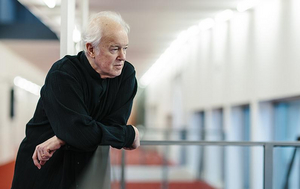Review: SAN DIEGO SYMPHONY: EDO DE WAART CONDUCTS BEETHOVEN at The Jacobs Music Center

Beethoven was born 250 years ago, and the world has been honoring the anniversary with a deluge of the great composer's music. The San Diego Symphony's celebration continued with strong, well-played performances of Beethoven's Egmont Overture and sixth symphony. Principal Guest Conductor Edo de Waart was once again at the podium. He was assigned most of the heavy lifting for this season's surfeit of Beethoven. The program also included Haydn's 92nd symphony, the "Oxford."
Beethoven wrote Egmont as incidental music for Goethe's play of the same name. It is a set of ten pieces for soprano, narrator and orchestra. The entire suite is seldom performed, and it's even rarer for it to include a narrator when it is. The thrilling overture, however, is heard often in both concert halls and in recordings. It's a stirring musical description of the Count of Egmont's heroism during a 16th Century Dutch struggle with Spain. The San Diego Symphony Orchestra responded to de Waart's direction with precision and power, building to the blazing finale with horns and trumpets to signal Egmont's victory. Alas, for him the victory was a moral one only. The count was beheaded by the Spanish invaders he had defied.
Since the advent of concern for original performance instruments and practices many conductors reduce string sections for the Classical-period symphonies of Haydn to match typical 18th Century orchestra sizes. San Diego conductors sometimes cut the section by half or more. This is especially effective for the earlier symphonies of both Haydn and Mozart. Section size is more a matter of taste for their later works. They can succeed either way, and de Waart had close to a full complement of strings for Haydn's "Oxford." That was useful in passages benefiting from a fuller sound, and the section played with such cohesion and careful intonation that quieter passages still had the lightness and delicacy needed. Woodwind solos were deliciously warm and winning, further enhancing the performance. The fleet bouncy joy of the last movement was ideally realized with just the right tempo and clear balances among sections in even the loudest moments, despite a preponderance of strings.
Beethoven's sixth symphony is usually described as his most relaxed and friendly, and that's because it is. Although Beethoven denied that it was programmatic, his description of each movement contradicts the denial. It's a leisurely walk in the woods, something he took often with reliably documented pleasure. Birds twitter, allowing the San Diego woodwinds to shine again as in the "Oxford." The strings took advantage of nature's beauty with lush, full-bodied pleasure. The brewing, and then actual storm of movements four and five gave brass and percussion their day in the sun, despite the rain and thunder. And as the storm clouds dissipated and the walk in nature came to an end, the audience had completed its own pleasing journey from heroic glory to satisfying serenity. Maybe I'm wrong, and we won't hear too much Beethoven this year--if it's always conducted and played as well as it was in this San Diego Symphony concert.
This review is of a January 25th performance. For a future concert schedule and ticket information visit the San Diego Symphony website.
Photo compliments San Diego Symphony
Comments

Videos

